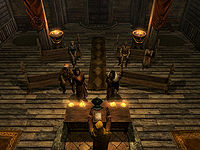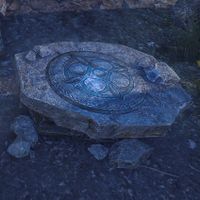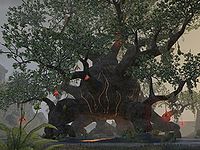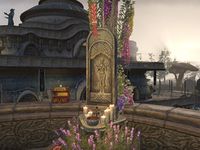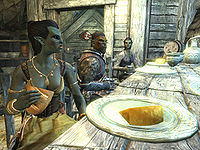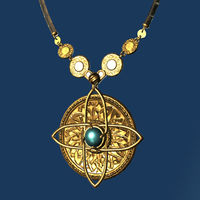Lore:Marriage
This article documents the many marriage traditions held by the various cultures and religions of Tamriel.
Marriage Under Mara[edit]
Mara is worshipped as the Goddess of Love and the patron of marriages by Altmer, Bosmer, Bretons, Imperials, Khajiit and Nords. Priests of Mara (or her Redguard counterpart, Morwha, under Crown form) officiate weddings all across Tamriel. Because of this, the Pledge of Mara is the most common form of union.[1] Ayleid clans who did not turn to Daedra worship, Falmer (before their corruption), and Kothringi[UOL 1] all worshipped Mara too, before their societies disappeared from Tamriel.[2][3][4]
Lowborns usually marry for love, while nobles will be more likely to take part in an arranged marriage to strengthen relationships between royal or noble houses. Reasons for marriage may differ among the different cultures.[5]
Imperial and Breton nobles are usually married between both close and distant noble families to sealed political alliances.[6][7] The Redguard High King Ar-Azal was polygamous, and married several people in an attempt to secure peace between Crowns and Forebears.[8]
Temples to the Eight and Nine Divines hold that Mother Mara loves all her children regardless of form. When two mortals, regardless of their race or gender, are married, it is their souls, not their bodies, that are united. This way, same-sex and interracial marriages are allowed under the Divines.[9] However, discrimination towards interracial couples exists, and civil administration sometimes disapproves this kind of union.[10]
Typically, priests of Mara officiate most marriages in their temples. The ceremony is arranged a certain time before by one of the members of the future union. The priest says a few words to the attendants before asking the participants to confirm their intention to marry one another. The priest declares them married, and the betrothed exchange matching rings. The exchange of rings between the couple will finish the ceremony, marking the start of the marriage. The couple is typically accompanied by their closest friends and family during the ceremony.[11]
Couples can marry without the assistance of a priest of Mara as well. Often, this is done by devoting themselves to the Goddess of Love at a Shrine of Mara, where the participants exchange Rings of Mara to seal the wedding before the Divines.[12] While it is unknown whether Reachmen worship Mara or not, the Eagleseer and Six-Ford clans intended to hold a handfasting ceremony upon an altar of Mara at Hroldan Ring to unite the two clans circa 2E 582.[13]
The Temple of Mara allows posthumous marriages in certain circumstances.[14]
Divorce[edit]
Divorce is the process by which married couples may be formally separated.[15] When two partners are divorced, their marriage is annulled.[16] Despite being officially separated, divorcees who have yet to remarry by the time their former spouse dies are still termed widows.[17]
Altmer[edit]
Altmer are famous for their interest in lineage and heritage over marriage out of attraction.[5] Summerset High Elves' marriages are commonly arranged and often loveless.[18] Highborn Altmer take the matter most seriously, which begins when a matchmaker is contacted to research the couple's star charts and pedigree documents. Family, physicality and other attributes are also taken into account. The couple seek guidance from priests, who can supposedly divine the auspiciousness of the future union: from the very suitability of the couple to the date of the wedding. Matchmaking usually lasts years or decades to solidify into a marriage.[19][20] Breaking an arranged betrothal usually leaves those involved labeled as outcasts to their own families and communities.[19]
Inter-class marriages are not unheard of, but they are despised by Summerset society.[21] Maintaining pure blood is the most important part of the relationship, so secret vampires and werewolves may turn to suicide or murder as a way out while keeping their own family's honor (and that of their betrothed) intact.[22][20] This focus on bloodline purity restricts interracial marriage between Altmer (especially Summerset Altmer) and members of the other races, though there have been notable exceptions throughout history. For example, Clan Direnni intermingled with their Nedic vassals, and Morgiah (a Dunmer and the daughter of Queen Barenziah) married the High Kinlord of Firsthold in the Third Era.[23][24]
Argonians[edit]
Argonian customs differ among the cultures of Black Marsh.
Some Argonians believe the Hist ensures that life-long mates meet and find love in each other. They think that the sentient holy trees make it so the future marriage to meet in place and in time, exactly when both of them are prepared for love and, later, marriage.[25]
One tradition dictates that the one who proposes will have to present a unique wedding ring to their potential mate to represent their future bond. The jewel is supposed to be forged in gold and to have three amethysts as part of the design. Two of the gems, the ones on the outside, represent the couple to be married: one for each partner. The amethyst in the center represents the Hist, the entity that all Argonians consider a sacred part of their lives.[26]
Some Argonians don betrothal veils woven of the wings of Shadowfen wasps.[27]
Murkmire[edit]
The Argonians of Murkmire have bonding rituals. Outsiders often compare the bonding ritual to a wedding, but such comparisons aren't wholly accurate. A bonding ritual isn't necessarily a "marriage", per se.[28] During the bonding ritual, the tribe chooses those who will lay and sire the next clutch of eggs.[29] Some partners choose each other, and present gifts to their partner or perform other customs in accordance with their tribe's traditions. While there is respect between the bonded pair, romantic feelings are not strictly necessary.[28]
Each tribe has their own bonding traditions, but there is overlap. A tree-minder performs the ceremony before the Hist. The bonded pair are blessed with good health and vibrant fertility, and the couple mates. The process of choosing a partner also varies. Sometimes, the decision is based on an emotional connection; others bond out of physical attraction. The Bright-Throat Tribe uses their ceremony to strengthen their political connections with other tribes.[28] The closest comparison to the Bright-Throats' bonding practice in other cultures is political marriages. The intention of the union between individuals of differing factions is similar, as the union strengthens relationships between factions.[30] However, the bonding ritual isn't a binding contract between two individuals that cements them together for life; there's more of an emphasis on increasing the tribe's numbers.
All tribes celebrate their own bonding in one way or another, but the Bright-Throat Tribe is especially notable for the liveliness of their festivities. The Bright-Throats invite suitors from neighboring tribes to participate in their bonding ceremony. It is a jubilant time where the other tribes are welcomed with feasts and phlegmwine. The Black-Tongues, the Moss-Skins, and the Root-House people commonly send suitors to bond with the Bright-Throats, being long-time allies of the tribe.[31] Participants are paired with a bonding partner, and a ceremony is held to celebrate the couples, the tribe's renewal, and the bonds of blood and kinship between the participating tribes. After the festivities, the couples retire to their nuptial huts and begin the process of bonding, wherein they procreate.[31] The Bright-Throat bonding ceremony is more than a mere display, it is a renewal of the tribe's vows with their neighbors. Canceling a bonding ceremony abruptly would give the other tribes cause to call the Bright-Throats' commitment to their allies into question.[32]
Bosmer[edit]
A ceremonial wedding known as "the Handfast" is spiritually important to the Green Pact Bosmer of Valenwood. This marriage is a binding between the Silvenar and the Green Lady, religious figures whose union represents the joining of the spiritual and physical sides of the Bosmer people.[33]
In the Second Era city of Vashabar, neither Green Pact nor Dawnway Bosmer would accept a marriage unless the couple received their parents' blessing.[34] However, this custom could be overridden by the Rite of Propagation, an ancient Valenwood rite that was rarely invoked. According to the teachings of Y'ffre, stagnation stands against the Green. To encourage growth, the rite allows two supplicants to invite their community to stand with them; the outcome of such a decision will be respected by the families.[35][36]
Breton[edit]
Arranging fortuitous marriages are the norm among Breton noble families,[37][UOL 2] but having courtships before choosing a partner is another option. In a courtship where one has a choice, suitors may present gifts of varying extravagance to the target in hopes of wooing them.[38] Other options may include a bouquet of rare flowers, or a serenade.[39] The practice of dowries exists in Breton marriages.[40] There is some societal expectations in your partner. A noble lady in a relation with her manservant would be considered forbidden love for example.[41] Bretons have the Law of Consanguinity, preventing marriage between those that are too close in blood relation.[42] Love charms are popular among Breton nobles and merchant lords who seek to improve their love lives.[43] Woman seeking to marry into the nobility may try to use an updo traditional to Breton high society.[44]
Druids are known to enter into marriages despite not adhering to the teachings of Mara, the Goddess of Love. Nevertheless, there is limited knowledge available regarding the specifics of Druid marriage ceremonies and customs.[45]
Some sources claim that in certain regions of the Reach and rural High Rock regions, spriggans are said to be charmed to participate in weddings by ensnaring the hands and feet of the betrothed with roots. Upon release, the spriggan can either leave peacefully or pose a threat to the couple. The outcome is viewed as an omen for the marriage's success. If the spriggan becomes hostile, it is defeated, and the couple consumes its sap to ward off any perceived curse. Scholars speculate on the tradition's possible connection to the Snow Elves.[UOL 3]
Dunmer[edit]
Both House Dunmer and Ashlanders honored their departed ancestors when they wed. Therefore, marriage traditions did not change when the Tribunal rose during the early First Era (when the Dark Elves were still known as Chimer), or when they fell in the late Third Era.[46] During the Tribunal's reign, House Dunmer wedding ceremonies took place at shrines to Almalexia, also known as Mother Morrowind.[47]
The member of the couple coming from the lesser clan is commonly brought into the greater clan. This member binds themselves through ritual and oath into the new clan, and gains communication and benefits from its ancestors; however, their access is lesser than those born into the bloodline. Despite this new bond, they retain some access to the ancestors of their own bloodline.[46]
Motivations behind Dunmer relationships and marriages are political in some cases when a high-ranking House Dunmer is involved.[46] However, for most of the common people, both House Dunmer and Ashlanders, attraction plays a key role in mating and selecting partners, who will marry or not in the future.[5]
In the past, House and Ashlander Dunmer usually did not marry between themselves due to their religious differences during the Tribunal rule; however, intercultural weddings were not unheard of.[48][49] After the rise of the New Temple, the previously persecuted Ashlanders, who had continued to worship the three Good Daedra throughout the Tribunal's rule, are now lauded as the keepers of the old ways. It is now quite common for many of the House Dunmer to make the arduous pilgrimages into the ash wastes, tightening ties between the two peoples.[50]
Although most Dunmer marriages are monogamous, polygamy is practiced in some situations. Same-sex marriages and relationships are accepted within Dunmer society.[51]
Nords[edit]
It is a common misconception that the early Nordic term "War-Wives" refers to wedded wives. The term is used interchangeably with "Shield-Sisters", and refers to women warriors. The term "War-Wife" also has little to do with the amorous relations she has with others; a War-Wife can be married to a Shield-Brother (warrior men) or a non-warrior. The relationships between War-Wives and their betrothed were mostly monogamous.[5]
Orcs[edit]
Orcish Stronghold marriages under the Code of Malacath are typically between the chief and numerous partners. The only male allowed to be married and to father children is the chief of the clan, a title gained and lost through challenge and combat.[52] He will marry an unlimited number of women, who become his hearth-wives, forge-wives, hunt-wives, and shield-wives.[53][52] Hearth-wives are the ones who will most commonly sleep with her chief and take care of household business; forge-wives are very appreciated among her strongholds, as they master the fires of the forges; hunt-wives are more common in isolated strongholds, where hunting is more important to the economy of her clan; and shield-wives are known to be fighters and accompany her chiefs in battle.[54][55]
Despite the Code of Malacath regulations, the chief and his wives aren't the only Orcs who effectively procreate. Many of the Stronghold Orcs are forming unions, that are not official according to the Malacath faith, despite the regulations imposed by the Code.[56]
Traditionally, the title of chief can only be achieved by male Orcs, but in certain exceptional circumstances, a female Orc may rule her clan.[57][53] During the successive foundations of Orsinium, Kings acted as primus inter pares chief and married a large number of other chiefs' daughters to strengthen the kingdom.[55][58] In cases where a female Orc breaks away from tradition, they will sometimes take on multiple husbands, and the husbands will fill the traditional role of the wives.[59] Some strongholds like Mor Khazgur have abandoned the more cruder aspects of the Code of Malacath and allow members of the stronghold to marry whoever they wish without restriction.[60]
There exists a certain Orcish traditional engagement ritual.[61] First, the suitor must smell of battle and of his enemy's blood. An Orc often fights a powerful foe before wooing a wife.[62] Then he must give the best echatere cheese and spiced ale to the maiden as a present, which they are thought to have aphrodisiac properties.[61] Finally, the wooer should recite a love poem, typically with war, blood, or revenge background, but at the same time, flattering.[63] Once performed, the maiden may or may not choose to accept the proposal.[61][64]
The sons of the clan will not be able to marry until they become chiefs of their own clan. Those unable to defeat their own fathers are destined to lowly duty to their clans or exile. The chieftain is replaced by whichever member of the clan grows strong enough to challenge and, usually, kill him.[52][65]
When a chief passes away, the mother of the next chief (and widow of the previous one) becomes the "mother" of the stronghold (or kingdom, in some cases). The name combinations are the same: Hearth-Mother, Forge-Mother, Hunt-Mother, or Shield-Mother.[58][52]
The daughters of the clan will often be betrothed to other chiefs to strengthen the relationship between allied clans or to forge new alliances. These arranged marriages are most valued. Orc women may want to escape being "just another wife" to the chieftain. They leave to join the Imperial Legion, see the world, or otherwise seek their fortune; some eventually return to the strongholds, but many do not.[52][66][65]
Marriage customs among Trinimac-worshiping Orsimer differ, as they do not follow the Code of Malacath.[55] The High King of the Orcs, historically the ruler of Orsinium, is allowed to practice polygamy, often marrying many more wives than even stronghold chieftains.[55] According to the teachings of High Priestess Solgra, if two Orcs are married at heart, it is as valid as a real marriage.[56] Depending on the political situation, an Orc chief may have no choice but to let other married Trinimac-worshiping Orcs reside in a stronghold.[67]
Orcs who live in the cities with other races are likely to face prejudice. Interbreeding with other races of Tamriel is so rare that it is commonly thought impossible.[68][69]
Traditionally, Orcs are married at the stroke of midnight.[70]
Redguards[edit]
It is uncommon for Crowns and Forebears to marry each other. In Bergama, such a thing is almost unheard of, as the Crowns and Forebears' allegiances have remained unchanged for many years.[71] Some Forebears believe that their kin shouldn't associate themselves with a Crown, let alone marry one, and vice versa.[72] Some Redguards believe that such a marriage would never last because the Crowns and Forebears are so different.[71]
Reachmen[edit]
Reachfolk marriages are traditionally preceded by handfasting, and are often political in nature. The promises can be organized without approval of the couple,[73] though their agreement is needed for the marriage to be officiated. They are sometimes called "marriage pacts",[74] and are used to end wars and strengthen alliances between clans. The handfasting vows are spoken in front of a mediator such as the Chief-of-Chiefs instead of a priest or shaman.[75] A Reachman can be promised to more than one suitor at a time,[73][76] but Reachfolk marriages are monogamous, and all other promises are broken upon the official ceremony of handfasting.[13]
Intended couples usually are isolated for a short period of time at the handfasting cave so they can learn about one another before the rites are pefrormed in case the suitors never meet each other prior to the ceremony.[75]
Handfasting rites are represented by traditional knotwork, which is often carved on rings.[77] The handfasting rite can be also performed in secrecy.[78] One way to perform handfasting rites is by sharing words of promise and exchanging the rings made of birch-wood.[79] Small beads carved from blue stone are used in Reach courtship rituals.[80]
Some couples fashion the Lover's Coil, a circular[81] totem made of stone symbolizing the couple's love by representing the spirals of the participants' lives entwining. If such a totem is destroyed, it can be interpreted as the spirits' displeasure and lack of the approval for the couple's union. This belief is not shared uniformly by all Reachfolk, as some find it superstitious.[82]
Unions and marriages between Reachfolk of the clans that venerate Hagravens (such as the Crow-Wife Clan) and Hagravens are permitted.[83][84] Married Hagravens are referred to as Hag-wives, while male partners of Hagravens are given the title of Hag-husband. Those who marry Hagravens are often respected and feared by the members of their clan.[84]
Some sources claim that in certain regions of the Reach and rural High Rock regions, spriggans are said to be charmed to participate in weddings by ensnaring the hands and feet of the betrothed with roots. Upon release, the spriggan can either leave peacefully or pose a threat to the couple. The outcome is viewed as an omen for the marriage's success. If the spriggan becomes hostile, it is defeated, and the couple consumes its sap to ward off any perceived curse. Scholars speculate on the tradition's possible connection to the Snow Elves.[UOL 3]
Other[edit]
Tsaesci are known to have had marriage,[85] a tradition they shared with the Imperial denizens of Hakoshae.[86] The Kothringi are likewise known to have practiced marriage,[87] but nothing is known of the specifics. Some sources claim that Snow Elves also engaged in marriages, and some speculate that remnants of their practices may have influenced the marriage customs of modern Bretons and Reachfolk.[UOL 3]
Gallery[edit]
Notes[edit]
- Though marriage has been seen among NPCs in many of the earlier games, more recent games also feature it as a gameplay mechanic among players.
- For game-specific information, see the Skyrim and Elder Scrolls Online articles.
See Also[edit]
- Heart's Day Mass Wedding by Loremaster Lawrence Schick — A special reading from a Heart's Day event
References[edit]
- ^ Varieties of Faith in the Empire — Brother Mikhael Karkuxor of the Imperial College
- ^ Shezarr and the Divines — Faustillus Junius
- ^ The Whithering of Delodiil — Unknown
- ^ Knight-Paladin Gelebor's dialogue in Skyrim
- ^ a b c d Augustine Viliane Answers Your Questions — Sibyl Augustine Viliane
- ^ Federic Seychelle's dialogue in ESO
- ^ Biography of the Wolf Queen — Katar Eriphanes
- ^ The Worthy Ar-Azal, His Deeds
- ^ Artorius Ponticus Answers Your Questions — Bishop Artorius Ponticus
- ^ Hasathil's dialogue in Oblivion
- ^ Maramal's dialogue during weddings in Skyrim
- ^ The Shrine of Mara's description in ESO
- ^ a b Events of Vows and Oaths in ESO
- ^ Tertia Falto's dialogue in ESO
- ^ Tharayya's dialogue in ESO
- ^ Volunidai's dialogue in ESO: Thieves Guild
- ^ Quintus Verres' dialogue in ESO
- ^ Kinlady Ilunsare's dialogue in ESO
- ^ a b Esterdel's dialogue in ESO
- ^ a b Niralin's dialogue in ESO
- ^ Tableau's dialogue in ESO
- ^ Nafarion's Note — Nafarion
- ^ Pocket Guide to the Empire, 1st Edition: High Rock — Imperial Geographical Society, 2E 864
- ^ Pocket Guide to the Empire, 3rd Edition: The Blessed Isle: Alinor and the Summersets — Imperial Geographical Society, 3E 432
- ^ The Hist's Fire — Pegareem
- ^ Talen-Jei's dialogue during Sealing the Deal in Skyrim
- ^ Wasp-Wing Betrothal Veil item description in ESO
- ^ a b c Chal-Maht's dialogue after Frog Totem Turnaround in ESO: Murkmire
- ^ Aliskeeh's dialogue during Empty Nest in ESO: Murkmire
- ^ Tseedasi's dialogue during Empty Nest in ESO: Murkmire
- ^ a b Bond-Guru Topeth's dialogue during Unsuitable Suitors in ESO: Murkmire
- ^ Tree-Minder Pavu's dialogue during Empty Nest in ESO: Murkmire
- ^ Diplomacy during the Handfasting
- ^ Laeni's dialogue in ESO
- ^ Rite of Propagation
- ^ The Voice of the Village quest in ESO
- ^ Druid Scapegoats — Druid Nivienne of the Eldertide Circle
- ^ Countess Ilise Manteau's dialogue in ESO
- ^ Julien Rissiel's dialogue in ESO
- ^ Meet the Character - Forge-Mother Alga — Tugha
- ^ Mathias Raiment's Journal — Mathias Raiment
- ^ The Story of Princess Eselde
- ^ Breton Love Charm item description in ESO
- ^ Breton Braids for Breton Brides item description in ESO
- ^ Elder Pitof's dialogue in ESO: Firesong
- ^ a b c Ancestors and the Dunmer
- ^ Shrine of Mother Morrowind in ESO
- ^ Kaushad's dialogue in Morrowind
- ^ Morrowind events
- ^ The Reclamations — Thara of Rihad
- ^ 36 Lessons of Vivec, Sermon 24 — Vivec
- ^ a b c d e The Code of Malacath — Amanda Alleia, Mercenary
- ^ a b Varieties of Faith: The Orcs — Brother Mikhael Karkuxor of the Imperial College
- ^ Chief Burguk's dialogue
- ^ a b c d King Kurog's dialogue
- ^ a b Ashgel's dialogue in ESO
- ^ Ushruka's dialogue
- ^ a b Forge-Mother Alga's dialogue
- ^ Snaruga's dialogue in ESO
- ^ Overseer Thulsgreg's dialogue in ESO
- ^ a b c Rulfala's dialogue
- ^ Yatzog's dialogue
- ^ Borasad's dialogue
- ^ Lazdutha's dialogue
- ^ a b Hunt-Wife Lurgush's dialogue
- ^ Lokra's dialogue
- ^ Balarkh's dialogue
- ^ Notes on Racial Phylogeny — the Council of Healers, Imperial University
- ^ Journal of the Lord Lovidicus — Lord Lovidicus
- ^ The Wraith's Wedding Dowry — Voltha gra-Yamwort, translated by Apthorne
- ^ a b Jagnas' dialogue during Left at the Altar in ESO
- ^ Enneh at-Tarin's dialogue during Left at the Altar in ESO
- ^ a b Esgiana's dialogue in ESO
- ^ Crafting Motif 97: Wayward Guardian Style — Arana of the Ghostsong Clan (as recorded by Count Verandis Ravenwatch)
- ^ a b Chief-of-Chiefs Cannear's dialogue in ESO
- ^ Madearn's dialogue in ESO
- ^ Ring of the Unrequited item description in ESO
- ^ Madearn's dialogue in ESO
- ^ The Translated Works of Tosmorn, II — Xandier Edette
Edited by Vanesse Aurilie - ^ Blue Bead quest item description in ESO
- ^ Lover's Coil Fragments quest item description in ESO
- ^ Vateshran Barth's dialogue in ESO
- ^ Winterborn's Note
- ^ a b A Life Barbaric and Brutal — Arthenice Belloq
- ^ Akaviri Diary Translation — Xhaferi
- ^ Ashur's dialogue in ESO: Elsweyr
- ^ Shul's Letter
Note: The following references are considered to be unofficial sources. They are included to round off this article and may not be authoritative or conclusive.
- ^ The Water-getting Girl and the Inverse Tiger
- ^ High Isle Chapter Preview
- ^ a b c The Wedding — Cassolar Draebo
